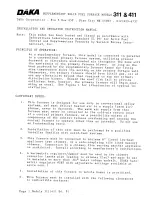
507651-01
Page 12 of 32
Issue 1907
Venting
A 4 inch diameter flue transition is factory installed on the
combustion air inducer outlet of all models.
These series units are classified as fan assisted Category
I furnaces when vertically vented according to the latest
edition of National Fuel Gas Code (NFPA 54 / ANSI
Z223.1) in the USA. A fan assisted Category I furnace is
an appliance equipped with an integral mechanical means
to either draw or force combustion products through the
combustion chamber and/or heat exchanger. This unit is
not approved for use with horizontal venting.
NOTE:
Use these instructions as a guide. They do not
supersede local codes. This furnace must be vented
according to all local codes these installation instructions,
and the provided venting tables in these instructions.
The venting tables in this manual were extracted from the
National Fuel Gas Code (NFPA 54 / ANSI Z223.1) and are
provided as a guide for proper vent installation. Proper
application, termination, construction and location of vents
must conform to local codes having jurisdiction. In the
absence of local codes, the NFGC serves as the defining
document.
Use self drilling sheet metal screws or a mechanical
fastener to firmly secure the vent pipe to the round collar of
the flue transition. If self drilling screws are used to attach
the vent pipe, it is recommended that three be used. Drive
one self drilling screw through the front and one through
each side of the vent pipe and collar. See Figure 16.
Install the first vent connector elbow at a minimum of six
inches (152 mm) from the furnace vent outlet. See Figure
Supply Air Plenum
If the furnace is installed without a cooling coil, a removable
access panel must be installed in the supply air duct. The
access panel should be large enough to permit inspection
(either by smoke or reflected light) of the heat exchanger
for leaks after the furnace is installed. The furnace access
panel must always be in place when the furnace is operating
and it must not allow leaks into the supply air duct system.
Return Air Plenum
NOTE:
Return air must not be drawn from a room where
this furnace, or any other gas fueled appliance (i.e., water
heater), or carbon monoxide producing device (i.e., wood
fireplace) is installed.
When return air is drawn from a room, a negative pressure
is created in the room. If a gas appliance is operating in
a room with negative pressure, the flue products can be
pulled back down the vent pipe and into the room. This
reverse flow of the flue gas may result in incomplete
combustion and the formation of carbon monoxide gas.
This toxic gas might then be distributed throughout the
house by the furnace duct system.
In upflow applications, the return air can be brought
in through the bottom or either side of the furnace. If a
furnace with bottom return air is installed on a platform,
make an airtight seal between the bottom of the furnace
and the platform to ensure that the unit operates properly
and safely. Use fiberglass sealing strips, caulking, or
equivalent sealing method between the plenum and the
furnace cabinet to ensure a tight seal. If a filter is installed,
size the return air duct to fit the filter frame.
SUPPLY
AIR
SUPPLY
AIR
ti
n
U
l
a
t
n
o
z
ir
o
H
ti
n
U
w
o
lf
p
U
Furnace
Furnace
Figure 14. Duct System and Proper Installation













































